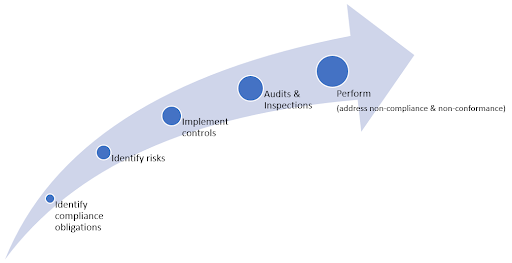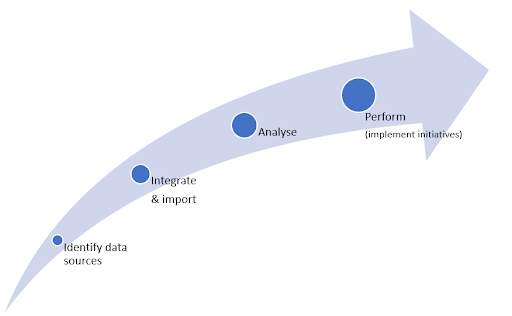
How energy management software offers users immediate value and the opportunity to have a positive impact on the world around them
Until recently, I have been working in the EHS sector helping some of the worlds largest companies select, implement, and maintain some of the leading Environmental, Health & Safety solutions. After more than 20 years, it’s not surprising that I had formed a firm opinion on how software should be implemented and deployed. The procurement cycle for an average EHS project can be somewhere between 12 and 18 months followed by an implementation project spanning several phases and lasting upwards of 6 months. Therefore, it takes some time for the new system to settle down and for new ways of working to take hold. Put simply, implementing solutions that affect operations across the whole organisation generally require a high level of project and internal change management.
Things are different here at Fabriq and during my first few weeks I have noticed that the duration of time from selection to making a real impact (time-to-value) is much shorter. Our goal is to automate data collection via integration and to ensure reliability and data quality regardless of location or format. We are looking for as much data as possible and at the highest frequency or intensity. Data is the foundation of any platform and once we have collected and centralised this, our platform can provide immediate insights that allow our clients to identify outliers, benchmark their assets and initiate targeted performance initiatives that provide the biggest impact in the shortest time. So, here are my initial thoughts on why energy management projects are much more agile than your average EHS implementation
High risk means high regulation:
High risk sectors like Oil & Gas, Pharma, Mining and Heavy Manufacturing etc. are not only high polluters but they understandably have some of highest environmental and safety incident rates too. High risk equates to very high regulation with big penalties for non-compliance. So, for high risk, highly regulated organisations, it all comes down to the need to maintain an audit trail or system of record. A repository of information that provides an auditor with evidence that your organisation understands its compliance obligations and is/has done all it can to make plans, set goals, analyse risk, and implement controls. The purpose of this often appears to be aimed at maintaining a “get out of jail free” card should the organisation exceed a limit defined in an environmental permit, incur an environmental incident, or breach a regulation. Risk management as well as the implementation and auditing of controls is the order of the day and performance is often an after-thought or seen as something that will eventually be reached once the system has matured.

Typical EHS Implementation (6 to 12 months)
The focus on producing and maintaining a system of record can detract from or delay the realisation of performance improvements and explains why, despite having IoT integration in their roadmaps and presenting their plans for industry 4.0 at every event, EHS solution providers have made slow progress. Just look at the latest Verdantix Green Quadrant and you will see that although these solutions possess impressive capabilities, there appear to be very few providers positioned within the “Innovators” quadrant. On the other hand, energy management solutions have been integrating with data sources and IoT devices for over a decade. Integration and automation are a must-have, and it must be achieved quickly and effectively.

Typical Energy Management Implementation (4 to 6 weeks)
Where EHS managers are driven by the need to provide a system of record, Energy managers are driven by the requirement to automate the collection of high resolution data and to provide real insights that allow for the identification and implementation of performance improvements that make a real difference and have an immediate impact. My impression at least, is that performance improvement is the aim from the offset.
Planet Earth is our hotel in space of which we are all just guests. The day-to-day health, safety and wellbeing of individuals is of course of the highest importance, but the pollution of our environment poses a risk to every person living today and of future generations.
Protecting ourselves by protecting the environment:
Over the years, I have had the privilege of attending many EHS industry events and have gained much knowledge from listening to business leaders discuss their strategy for protecting people and the environment. To be honest though, I always wondered why almost all of what was presented was Health & Safety related. Protecting the environment is mostly seen as a long-term objective while reducing safety incident rates is in constant focus. I made this point at an event in Berlin a few years back and received a lot of positive feedback. My presentation began by calculating how much air an average person consumes in one day and multiplied this by the number of people that populate our planet (7 billion). I then added calculations for boilers, cars, manufacturing and so on. Not surprisingly, the mass of air required for humanity to function on a day-to-day basis was breathtaking (pun intended). I went on to show a picture of our planet from space and to point out the fragile thin blue line that constitutes our breathable atmosphere. As explained by NASA, if the Earth were the size of a basketball, the thickness of the atmosphere could be modelled by a thin sheet of plastic wrapped around the ball.
The point I tried to make with my presentation has also been presented, much more eloquently, by our partners, Considerate Group: 'planet Earth is our hotel in space of which we are all just guests. The day-to-day health, safety and wellbeing of individuals is of course of the highest importance, but the pollution of our environment poses a risk to every person living today and of future generations.'
As we all know, the built environment accounts for a staggering 35% of total energy consumption and nearly 40% of carbon emissions globally. There is clearly a huge potential for efficiency and cost savings within the real estate sector and I am proud to be part of an amazing team of people who have developed a product that not only delivers real value within a short timeframe, but contributes to a cleaner, safer environment.

